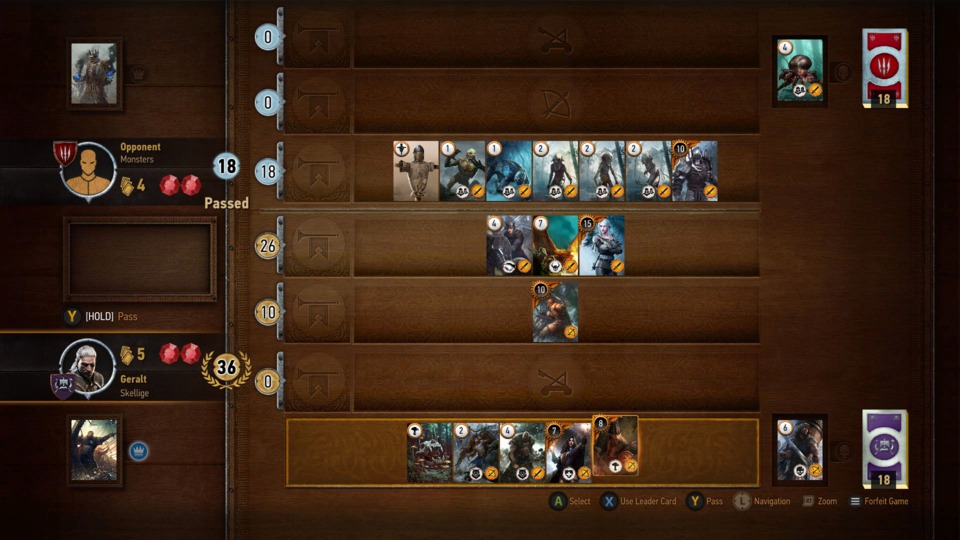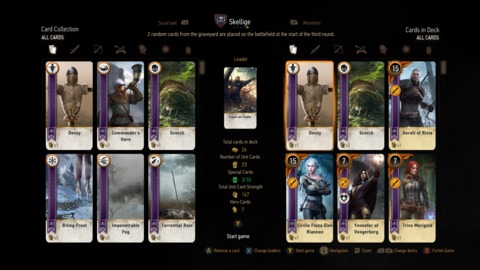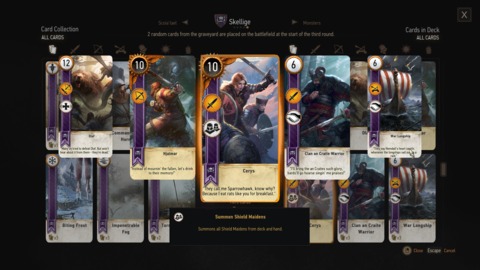Gwent: A Review
By Darth_Navster 34 Comments
Gwent, the collectible card game (CCG) nestled in every corner of The Witcher III: Wild Hunt, may very well be my favorite aspect of my favorite game of 2015. The deck building, collecting, and strategy of Gwent proved to be endlessly entertaining and I often found myself shirking witcher duties to play yet another match with the local innkeep. With the release of the Blood and Wine expansion and its introduction of new cards and faction, I was once again pulled into playing more of the irresistible card game. Gwent, how much do I love thee? Let me count the ways.

For those who haven’t played The Witcher III, or for those that have but couldn’t be bothered with yet another minigame, Gwent is a CCG akin to Magic: The Gathering or Hearthstone. The game is played by two players, each with their own customized deck. Players begin the game by each drawing ten cards from their deck and flipping a coin to see who goes first. The players then alternate taking turns by playing cards, activating abilities, or permanently passing their turn once they are satisfied with their board position. Most of the time players will play unit cards, which can be creatures, soldiers, or named heroes such as Geralt or Yennefer. Each unit card has a certain number of strength points, which are added up when both players choose to permanently pass their turn. The player with the higher strength total wins the round, and whichever player wins two out of three rounds takes the match. The most intriguing part of all this is that, unlike other CCGs, the game does not allow further draws after the match starts. What this means is that the initial draw of ten cards must last all three rounds of the match, barring additional abilities, and that opens up some intriguing strategic considerations. Should you over-commit on round one even if that limits your options for rounds two and three? Should you build your deck with weaker cards that allow you to draw more from your deck? It’s all very well considered for something that could have easily been dismissed as a niche minigame in an otherwise expansive world.

Speaking of the expansive world, one of the neat things about Gwent is how well integrated it is in the customs of the land. Geralt seems to be able to locate a fellow enthusiast no matter where he goes, be it in the brothels of Novigrad or the taverns of Toussaint, and there’s good coin to be made in wagering on games. Furthermore, almost every person Geralt defeats will provide him with another card for his ever-growing collection in a viscous cycle I like to call gottacatchemallism. It seemed odd at first that kings and barons would be obsessed with an ersatz Yu-Gi-Oh!, but eventually I began to buzz at the sight of a Gwent option in a dialog tree. Plus, those barons and kings offer much better cards than your average barfly, so I was more than willing to put aside urgent life or death matters for a match or two.
Gwent also takes on flavor from its world, with the five factions each representing a major power in the Continent’s geopolitical landscape. To build a deck, one must first choose which faction to play, be it the freedom fighting Northern Realms, the expansionist Nilfgaardian Empire, the reclusive elven Scoia’tael, the chaotic Monsters, or seafaring Skellige. I like the faction system in theory as it forces players to use different strategies. For instance, with the Northern Realms faction I was able to deploy spies and gain card advantage over my opponent, whereas with the Monsters faction I was able to overwhelm my opponents with plenty of unit cards. However, in practice the factions end up playing quite similar for two reasons. First, the game is dominated by hero cards that are not tied to any faction. These hero cards, which include characters like Ciri, are immensely powerful units that cannot be removed from the board or have their strength mitigated. As such, any successful deck includes a fair number of these hero cards regardless of faction. Second, the most important non-unit cards, such as Scorch or Decoy, are also factionless and so will be included in just about every deck. However, that’s not to say that the factions are completely irrelevant. Each faction comes with a set of leaders with unique abilities, such as the ability to destroy certain units or buff up units, that can tilt the game one way or another. In addition, the factions have innate abilities that activates regardless of chosen leader or deck composition. As examples, the Scoia’tael always go first to start the match and Monsters are able to keep a random unit on the board between rounds.

The murky differentiation of Gwent’s factions is probably it’s greatest weak point, and I can imagine that savvy players would be able to crack its metagame in no time at all. Had Gwent been designed to be a competitive human against human game, this aspect may have sunk its viability. But luckily, the game is played exclusively against NPCs who wouldn’t know deck optimization from the werewolf that’s eating their kin. Because of this I was able to experiment with suboptimal decks for the sake of variety and still be able to compete. This was best demonstrated as I tried out Skellige, the newest faction introduced in Blood and Wine. Skellige’s big mechanic are berserker cards that can transform into superpowered bears in the presence of a mushroom called mardroeme. While the mechanic is quite situational as it requires two or more cards in the same hand to work effectively, it’s loads of fun when you’ve turned a whole row of berserkers into bears with 20 strength each.
As far as card-based minigames go, Gwent is probably the best one I’ve played since Pazaak in Star Wars: Knights of the Old Republic. Gwent succeeds because it recognizes both the limitations and advantages of being part of a much larger RPG. It eschews the complex nature of standalone CCGs in favor of a much simpler play style and straightforward deck building. It also utilizes the back story and characters from The Witcher canon to create evocative and beautiful cards. But above all, it recognizes that since the player will only play against the computer, there’s no reason to care about fully balancing the game. Gwent allows savvy players to “solve” it and it doesn’t punish them from running the table against NPCs. While I’m not so much a Gwent nut that I would mod it to replace combat, I still enjoy it immensely. For those of you starting a new game of The Witcher III, or even those jumping back into the new expansion, I recommend taking some time to play cards. There’s a whole world of strategy for Geralt to partake in, and it’d be a shame to miss it.